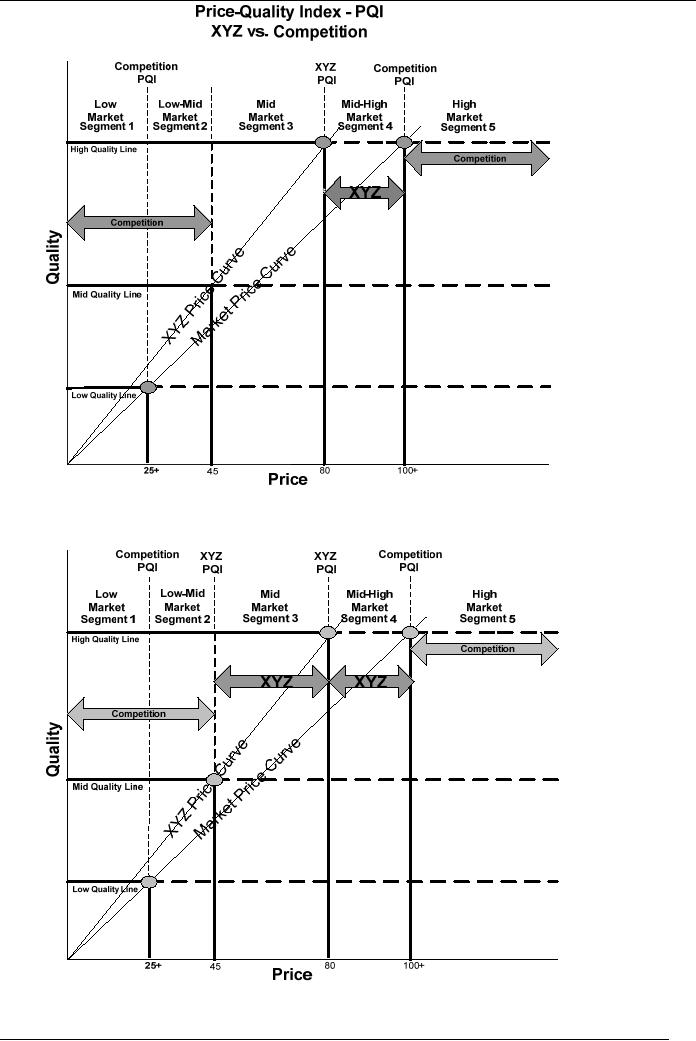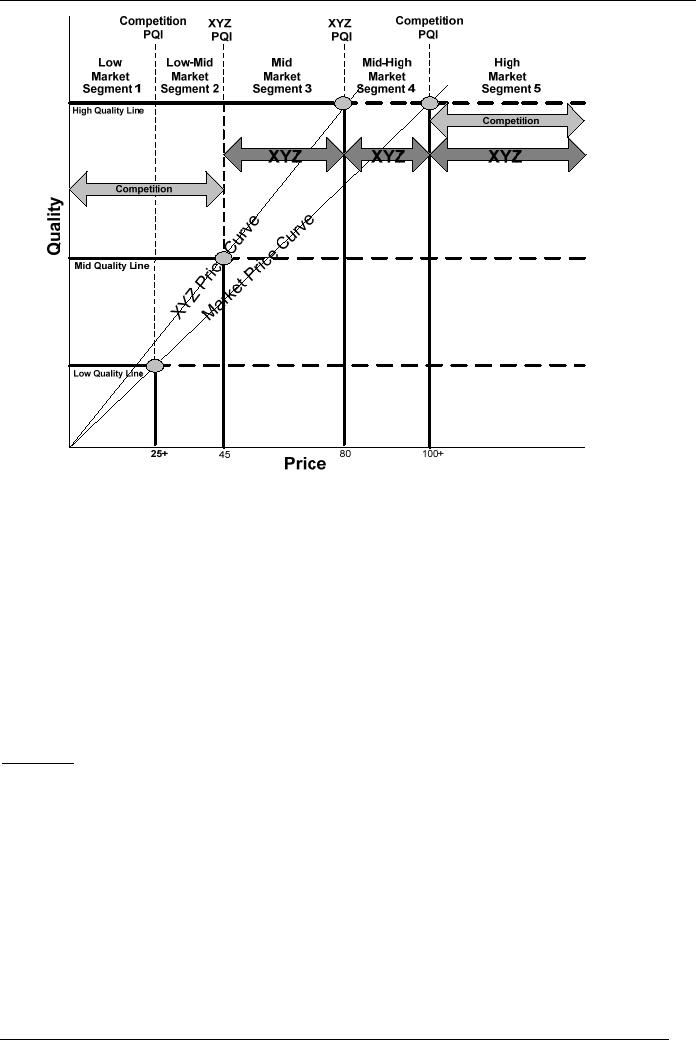 |

Brand
Management (MKT624)
VU
Lesson
7
BRAND
VISION
Purpose
of brand vision
To
earn the right level of
profitability, you have to
leverage your brand rightly.
It is here that
we
start treating brand as an
asset and manage that asset
by having a vision.
Vision
fulfills three basic
purposes1
�
Consensus
among management
�
Commits
company to research
�
Mandates
telling all
stakeholders
Consensus
among management: A bottom-up
approach, it extracts understanding
and
consensus
from management about
brand's contribution. All concerned
with the brand
give
their
input regarding brand's
potential and an effort is made to
have all of them
committed
to
the respective tasks they
are to perform toward
brand's contribution.
Brand
vision brings management to a platform
from where they all
have to agree what
level
of
growth the brand will
generate to fulfill company's
objectives. It is not a function
limited
to
the boundaries of marketing
management; it is an objective for
total management to
agree
on one point brand's reason
for being (why it exists?)
and its potential
toward
profitability.
The
question of why the brand
exists entails detailed
discussion on many exciting
areas of
marketing,
which will be touched upon
from time to time in their
proper perspective
throughout
the course. What it essentially
means is the "fulfillment of a
particular need" of
customers.
Identifying the right need
and then committing yourselves to
fulfill that with
the
right
product takes you on the
journey of starting with a
vision to complete development
of
the
brand.
Commits
Company to research: Consensus
leads management to initiate research on
so
many
vital research projects.
Because of the commitment, no one
wants to make decisions
without
any solid basis. The
tendency to make assumptions on the
ground that we know
the
market
well and therefore there is no
need for research should be
avoided. Only
research
provides
the company with grounds
like:
o
Customer
attitudes and usage
o
Brand
attributes to maintain and change
o
Segmental
changes; multi-segment brands
o
Geographical
changes; new categories
etc.
The
list is not exhaustive. It can be
much longer depending on the
needs of the company
at
any
given point in time.
Knowing
customers' attitudes offers
insights into product
build-up, service
requirements,
and
any other fulfillment of
customers' requirements. Maintaining or
changing product
attributes
relate responding to changing
needs, preferences, and competitive
pressures that
exist
and the ones that are
anticipated.
You
can also determine the differences
among different offerings of
the brand as
perceived
by
your consumers in different
segments of the market. You can make
decisions about
which
segments are more attractive
and which are less
attractive. That may also take
you
into
what geographic areas to be emphasized
more in relation to strength of
different
offerings.
Brand strength may lead the
management to start considering
introducing its
brand
across categories. What is it that
took Nestle from milk to
yogurt to juices to
chocolates?
This is a good example of going
across categories.
29

Brand
Management (MKT624)
VU
Management
can either stick to its
vision and plans or change it according
to the findings of
market
research. As you go along the
learning path you will
realize that almost at every
step
you
can undertake a research project.
Research does not have to be
tedious, cumbersome,
and
expensive. Small and simple
research designs can lead you to
verify your hypotheses
as
the
need emerges.
Mandates
telling all stakeholders:
Since
vision is well thought-through and
shared by all
in
the company, it mandates
that management tell all
stakeholders to know and share it
as
well.
Sharing the vision means
that stakeholders will also know
the objectives that are
a
reflection
of the vision.
The
present day's competitive pressures
have made the day-to-day
management very fast
paced
and, hence, prone to dynamic
changes and adjustments. Information on
past
performance,
recent trends, and research
findings present a strong case
for the brand
plan
and
vision. Having support from
all stakeholders toward your
brand objectives makes
the
job
of management less difficult. It also
keeps the blame game and
finger pointing from
taking
place if things go wrong. Going
right strengthens management's
confidence.
Let
us now try to develop
hypothetical vision and mission
statements of a fast food
company
that is planning to enter
the category of fast food.
The exercise is intended to take
you
through a case that offers
an opportunity of developing a practical
understanding of the
concepts.
After
you feel comfortable with
the learning process, you
may like to develop
similar
statements
of any business you may
envision yourself handling or
heading.
Vision
Statement of a Fast Food
Company
"The
company will enter the fast
food category by introducing a range of
quality
sandwiches
with brand name XYZ; the
sandwiches will have health-food-appeal
for lunch
time
in particular and anytime later in
general. It will price the
entries within the
consumer
friendly
range to optimize the number of
customers, who are
professionals within the
age
bracket
of 20-50 years. It will attempt to reach
its potential customers at
their door step and
always
stay close to where they
are".
As
is clear from the statement,
the company's business model
will be based on three
fundamental
factors of
�
High
quality
�
Affordability
�
Accessibility
The
basic objective of this
statement is to emphasize the point
that vision relates the
future.
The
statement talks about the
nature of the product and
how it envisions entering
the
category
with consumer-friendly pricing
within the target market.
(The
statement is a little
longer
than the usual vision statements. It is
designed to basically enhance
your ability to
develop
one independently).
We
shall be referring to the
implications of this statement
frequently to see that every
thing
said
in the statement has a
meaning in terms of brand
management. The figures 10 -
12
exhibit
the translation of consumer-friendly
pricing as it fits into the
market gap that will
allow
the company to optimize its
sales.
We
can sum up the components of
this statement into the
following:
o
It
explains the overall goal of
the brand
o
It
defines the target
market
o
It
underlines the need to have
differentiated sandwiches
o
It
makes it easy to translate
the above three components
into financial goals
30

Brand
Management (MKT624)
VU
If
you think that XYZ has to
create more than one
sandwich with different
taste profiles in
order
for its customers to have
choice, then your thinking
is practical. If you think
that XYZ
should
deliver sandwiches at the doorstep of
its customers, then your
understanding is
correct.
And, if you think that XYZ
by saying "close to where
its customers are"
should
also
create its own restaurants,
then your vision is
comprehensive about the
future business
make-up.
Should you also think that
the statement will have
implications in terms of
specialist
personnel to operate restaurants;
your vision is then absolute
and totally inclusive
about
the nature of business.
Mission
being the business at hand,
the statement will look like
the following:
Mission
statement of XYZ
"XYZ's
mission is to develop a team of delivery
personnel conversant with
the job of
delivering
food with high efficiency
and low operational costs. Part of its
mission is also to
simultaneously
develop fast food outlets
with appealing but
economy-driven architectural
features,
from where it can serve its
customers through highly-trained and
motivated crew."
We
are assuming that XYZ has in
place all requirements fulfilled
for the right
human
resource
for sandwich making and
purchasing on daily basis of
the requisite
supplies.
Sustaining
the operations through
excellent systems and procedures are part
of the
development
process.
Brand
Value Statement
"XYZ
professes integrity of character,
conscientiousness of work ethics,
quality
consciousness,
and mastery of skills as its
basic values."
To
have the quality of
sandwiches as envisioned by XYZ, it is
important to have the
staff
inculcate
the declared values. It should take
special training sessions and periodic
refresher
meetings
to renew company's commitment to
the professed values.
31

Brand
Management (MKT624)
VU
Figure
10 above
Figure
11 below
32

Brand
Management (MKT624)
VU
Figure
12
The
three figures show a grid
representing on the x-axis
five segments of price and on
y-axis
three
levels of quality. The
intersection of the price
line and the quality line
represents one
particular
price-quality index that
basically defines one particular segment.
You can have as
many
price lines as you may
deem representing the actual
market situation.
XYZ
makes an entry in "mid-high
market segment 4" (figure 10) and
later plans to enter
with
different
offerings into "mid-market segment 3"
(figure 11) and "high-market segment
5"
(figure
12) later on. The
strategic moves are a
translation of the vision
the company developed
for
itself. Workings on the
moves as are evident from
the figures are all
about company's
mission
and strategies that flow out
of the vision and
mission.
Key
point
Vision
generally represents a time
frame of 5 to 10 years. Once
translated into mission, it
stays
intact
for a couple of years or more. It is
said that a mission
statement should not be
changed
before
two to three years
approximately.
33

Brand
Management (MKT624)
VU
Glossary
of terms:
Contribution:
Contribution margin is the gross proceeds
after deducting the direct
variable
costs
a company incurs on making a product.
The higher the contribution, the
greater the
potential
the brand has to lift the
business toward the breakeven
point.
Brand
attributes: Features of the brand
that characterizes brand's
personality.
Offerings:
An introduction of a product, or a
product; generally, it is used
owing to brand
extensions.
If a brand has more than one
extension, for example regular
yogurt and the one
with
higher calcium, then the brand
has two
offerings.
Stakeholders:
All those individuals and
entities that have stakes in
the business. They may
not
be
shareholders, but they are
affected by the performance of the
company in one way or
the
other,
for example banks and
suppliers of raw materials.
Business
model: The strategic frame
work on which rests business' strategic
moves.
Bibliography:
1.
Scot M. Davis: "Brand Asset
Management Driving Profitable
Growth through
Your
Brands";
Jossey-Bass, A Wiley Imprint
(38-39)
34
Table of Contents:
- UNDERSTANDING BRANDS – INTRODUCTION:Functions of Brand Management, Sales forecast, Brand plan
- INTRODUCTION:Brand Value and Power, Generate Profits and Build Brand Equity
- BRAND MANIFESTATIONS/ FUNDAMENTALS:Brand identity, Communication, Differentiation
- BRAND MANIFESTATIONS/ FUNDAMENTALS:Layers/levels of brands, Commitment of top management
- BRAND CHALLENGES:Consumer Revolt, Media Cost and Fragmentation, Vision
- STRATEGIC BRAND MANAGEMENT:Setting Objectives, Crafting a Strategy, The Brand Mission
- BRAND VISION:Consensus among management, Vision Statement of a Fast Food Company, Glossary of terms
- BUILDING BRAND VISION:Seek senior management’s input, Determine the financial contribution gap
- BUILDING BRAND VISION:Collect industry data and create a brand vision starter, BRAND PICTURE,
- BRAND PICTURE:Brand Value Pyramid, Importance of being at pinnacle, From pinnacle to bottom
- BRAND PERSONA:Need-based segmentation research, Personality traits through research
- BRAND CONTRACT:The need to stay contemporary, Summary
- BRAND CONTRACT:How to create a brand contract?, Brand contract principles, Understand customers’ perspective
- BRAND CONTRACT:Translate into standards, Fulfill Good Promises, Uncover Bad Promises
- BRAND BASED CUSTOMER MODEL:Identify your competitors, Compare your brand with competition
- BRAND BASED CUSTOMER MODEL:POSITIONING, Product era, Image Era, An important factor
- POSITIONING:Strong Positioning, Understanding of components through an example
- POSITIONING:Clarity about target market, Clarity about point of difference
- POSITIONING – GUIDING PRINCIPLES:Uniqueness, Credibility, Fit
- POSITIONING – GUIDING PRINCIPLES:Communicating the actual positioning, Evaluation criteria, Coining the message
- BRAND EXTENSION:Leveraging, Leveraging, Line Extension in detail, Positive side of line extension
- LINE EXTENSION:Reaction to negative side of extensions, Immediate actions for better managing line extensions
- BRAND EXTENSION/ DIVERSIFICATION:Why extend/diversify the brand,
- POSITIONING – THE BASE OF EXTENSION:Extending your target market, Consistency with brand vision
- DEVELOPING THE MODEL OF BRAND EXTENSION:Limitations, Multi-brand portfolio, The question of portfolio size
- BRAND PORTFOLIO:Segment variance, Constraints, Developing the model – multi-brand portfolio
- BRAND ARCHITECTURE:Branding strategies, Drawbacks of the product brand strategy, The umbrella brand strategy
- BRAND ARCHITECTURE:Source brand strategy, Endorsing brand strategy, What strategy to choose?
- CHANNELS OF DISTRIBUTION:Components of channel performance, Value thru product benefits
- CREATING VALUE:Value thru cost-efficiency, Members’ relationship with brand, Power defined
- CO BRANDING:Bundling, Forms of communications, Advertising and Promotions
- CUSTOMER RESPONSE HIERARCHY:Brand-based strategy, Methods of appropriations
- ADVERTISING:Developing advertising, Major responsibilities
- ADVERTISING:Message Frequency and Customer Awareness, Message Reinforcement
- SALES PROMOTIONS:Involvement of sales staff, Effects of promotions, Duration should be short
- OTHER COMMUNICATION TOOLS:Public relations, Event marketing, Foundations of one-to-one relationship
- PRICING:Strong umbrella lets you charge premium, Factors that drive loyalty
- PRICING:Market-based pricing, Cost-based pricing
- RETURN ON BRAND INVESTMENT – ROBI:Brand dynamics, On the relevance dimension
- BRAND DYNAMICS:On the dimension of knowledge, The importance of measures
- BRAND – BASED ORGANIZATION:Benefits, Not just marketing but whole culture, Tools to effective communication
- SERVICE BRANDS:The difference, Hard side of service selling, Solutions
- BRAND PLANNING:Corporate strategy and brands, Brand chartering, Brand planning process
- BRAND PLANNING PROCESS:Driver for change (continued), Brand analysis
- BRAND PLAN:Objectives, Need, Source of volume, Media strategy, Management strategy